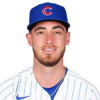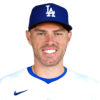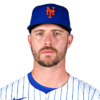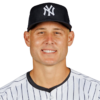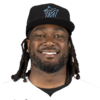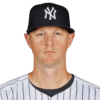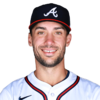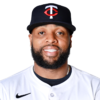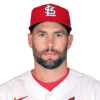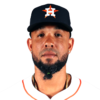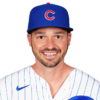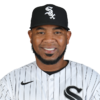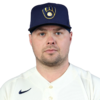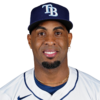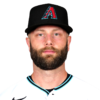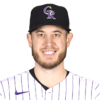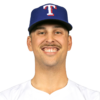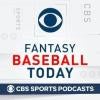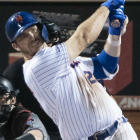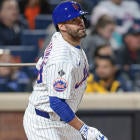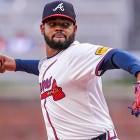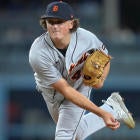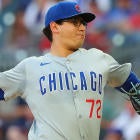As I was going through this same process a year ago, still unaccustomed to a world where everybody who's anybody hits 20 home runs, a panic began to set in when I first observed that the newfound depth seemingly every position enjoyed had somehow bypassed what had always been the deepest position, first base.
So how'd that turn out in 2019?
First base was as deep as ever, of course, in part because of high-profile breakouts like Pete Alonso and Josh Bell, but in larger part because this isn't just the age of the 20-homer guy. It's also the age of versatility, and it turns out first base is the easiest place to move a player when a team just has to have him in the lineup. All it takes is five appearances to gain eligibility there in-season, and plenty a useful bat reached that mark in 2019.
But the standard for retaining eligibility from one season to the next is higher — specifically, 20 appearances. I point this out because several of the players who you might naturally regard as first basemen will no longer be such at the start of 2020. Most notable is Joey Gallo, but also Hunter Dozier, Miguel Sano, Mark Canha, Ryan McMahon, Matt Carpenter, Ian Desmond and Wil Myers. That's of course only a partial list.
We know how this ends, though, right? Bunches of hitters who we don't even see coming — or perhaps even some from the above list — will find themselves playing first base often enough to pick up eligibility there, and the number of useful Fantasy options at the position will multiply.
Truth is it's not looking so bad this year to begin with. In fact, sorting out the middle portion of this top 20 will be a source of agony for me all offseason.
| 1 |
Cody Bellinger
Los Angeles Dodgers RF
|
| Despite his MVP credentials, some will harp on Cody Bellinger's suspect batting average over the final four months. But the strikeout rate remained greatly improved throughout, and the hard-hit rate was still top of the line. Factor in some bad BABIP luck, and it's reasonable to conclude that early-season Bellinger was the truer form. | |
| 2 |
Freddie Freeman
Atlanta Braves 1B
|
| Turns out 2018 was the outlier in Freddie Freeman's long-running development as a slugger. He nearly achieved the 40-homer season he had long teased but without compromising his status as the game's preeminent line-drive hitter, making him a near lock for a .300 batting average. Fair to say he doesn't give you much to worry about on Draft Day. | |
| 3 |
Pete Alonso
New York Mets 1B
|
| Pete Alonso arrived to promises of an 80-grade power bat and certainly delivered on them, breaking the rookie record for home runs. Compared to Aaron Judge and other sluggers of that ilk, Alonso's strikeout rate is fairly tame, and there's nothing else you could point to (except maybe the sight of him shirtless) that would raise questions of sustainability. He won't contend for batting titles, but he's worth a premium nonetheless. | |
| 4 |
Anthony Rizzo
Chicago Cubs 1B
|
| For a second straight year, Anthony Rizzo's power production fell a little short, which is especially precarious at a time when league-wide power numbers are spiking. He's such a solid all-around hitter, though, that you don't have to worry about him pulling the rug out from under you even if his ultimate ceiling is capped. He's an unquestioned, time-tested stud. | |
| 5 |
Josh Bell
Pittsburgh Pirates 1B
|
| Unfortunately, Josh Bell's 2019 will be remembered less for the rise than the fall, given the timing of it all, but the overall numbers still made him out to be of the season's biggest breakouts and a clear standout at a deep position. He finished better than he got credit for, too, confirming the gains in power and plate discipline even if he still left reason to wonder about the batting average. | |
| 6 |
DJ LeMahieu
New York Yankees 2B
|
| DJ LeMahieu is shaping up to be one of those players who I like better than the consensus. He defied the narrative of the struggling ex-Rockie, finding a way to improve even upon leaving Coors Field, and doesn't fit the profile of what a good hitter should be in 2020, his value being largely driven by batting average. The batted-ball profile mostly backed up what he did, though -- right down to the career-high home run total -- and batting leadoff in maybe the most loaded lineup should keep his floor high. | |
| 7 |
Max Muncy
Los Angeles Dodgers 2B
|
| By most every measurement, Max Muncy validated his breakthrough 2018, and since he again performed just as well against lefties and righties, he also putting to rest concerns of him slipping into a platoon role. Like LeMahieu, he'll also be eligible at second base, which gives him a leg up over similarly impactful bats, and it becomes even harder to argue his placement here in leagues that reward his walks and on-base ability. | |
| 8 |
Matt Olson
Oakland Athletics 1B
|
| Matt Olson's raw numbers make a strong enough case on their own, especially when you factor in the time he missed with a broken hamate bone at the start of the year, but predictive measures like xBA and xwOBA suggest he actually underachieved a bit. Could the then-26-year-old be in line for another step forward next year? Holding him back are some pretty nasty splits both at home and against lefties. | |
| 9 |
Carlos Santana
Cleveland Indians 1B
|
| A career year for a 33-year-old is always cause for skepticism, and it's worth noting in Carlos Santana's case that the numbers normalized quite a bit in the second half, his fly-ball rate lifting back to a level that's liable to make him a liability in batting average. His strikeout-to-walk ratio is always so good that you could make the case for him going a spot higher, if not three, in points leagues, but the guys ahead of him here also have plenty of potential in that format. | |
| 10 |
Paul Goldschmidt
St. Louis Cardinals 1B
|
| Whether you're measuring it in batting average, OPS or Head-to-Head points per game, the 2019 season was a major disappoint for the consensus No. 1 first baseman coming in, and it's not like Paul Goldschmidt didn't raise concerns of a decline in 2018 as well. Reports of his demise may be exaggerated, though, when you consider his batted-ball profile -- from the exit velocity to the hard-hit, line-drive and strikeouts rates -- was largely unchanged. There are too many terrific alternatives to give him full benefit of the doubt, though. | |
| 11 |
Rhys Hoskins
Philadelphia Phillies 1B
|
| Much of the shine has worn off Rhys Hoskins in a way that doesn't seem totally fair given that his batted-ball profile remains largely unchanged. But being another year removed from his scintillating first two months in 2017 has helped clarify he's an imperfect hitter who sells out so hard for power that he can't get enough hits in play to deliver a respectable batting average. A high walk rate helps make up for it in certain formats, but even so, it's hard to overlook him hovering around the Mendoza Line for four months. | |
| 12 |
Jose Abreu
Chicago White Sox 1B
|
| In the end, Jose Abreu's numbers looked about like they always do. It's just that they don't stand out as much in a record-setting offensive environment. He's less of a batting average liability than most slugging corner infielders, which helps in traditional 5x5 leagues, but in any format that rewards walks, he loses something. Also hurting his case is the fact he'll be 33 next year and possibly playing somewhere other than Guaranteed Rate Field for the first time. | |
| 13 |
Trey Mancini
Baltimore Orioles RF
|
| Trey Mancini has some of the same drawbacks as Abreu but without any of the track record. In fact, the change that seemed to be fueling his breakout at the start of the year (an improved fly-ball rate) normalized over the long haul, his ground-ball rate spiking so high in August that it's a wonder he sustained his home run pace as well as he did. With a miserable supporting cast, Mancini can't afford too big of a stumble. | |
| 14 | 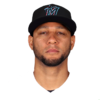
Yuli Gurriel
Houston Astros 1B
|
| Yuli Gurriel's per-game production placed him between Alonso and Rizzo in Head-to-Head points leagues, so there's a case for him to rank even higher than this. But that thing I said about 33-year-olds having career years (see Santana, Carlos) applies double to this 35-year-old, whose unexpected power came mostly during a two-month span. Plus-plus contact skills and an everyday role in a championship-caliber lineup should make him useful even if he's not as good as his numbers suggest this year. | |
| 15 |
Edwin Encarnacion
New York Yankees DH
|
| A number of the players at this position have age concerns heading into 2020, but none as pronounced as that of Edwin Encarnacion, who'll be turning 37 this offseason. He'll also be looking for a new team, and there's no guarantee one fully buys in at his age. The decline has been a mild one so far, with him still managing to put together eight consecutive 30-homer seasons, but the supporting stats aren't what they once were and the injuries are becoming more commonplace. | |
| 16 |
Luke Voit
New York Yankees 1B
|
| Had the season ended at the All-Star break, Luke Voit might have been four or five spots higher on this list, having emerged as an integral part of the Yankees lineup with plus on-base skills, considerable power and a line drive-fueled, high-BABIP stroke. But then he suffered a sports hernia that cost him some time and didn't look the same thereafter. Seeing as he took a back-door route to the starting first base job, it wouldn't take much for the Yankees to experiment with Mike Ford or Miguel Andujar there instead. | |
| 17 |
Yandy Diaz
Tampa Bay Rays 3B
|
| The Yandy Diaz experiment was a success only impeded by his inability to stay on the field, most notably because of a fractured foot that shut him down for good early in the second half. And while he does make hard contact at a high rate, there are some who question whether the Rays actually improved his launch angle enough to explain the big increase in home runs. Factor in that team's obsession with infield depth, and Diaz will be a risky, albeit potentially rewarding, pick. | |
| 18 |
Christian Walker
Arizona Diamondbacks 1B
|
| Christian Walker is a surprise not only in that he delivered on his first legitimate big-league opportunity at age 28 but also that he did it while Kevin Cron was making waves at Triple-A. The Diamondbacks must see something they like in him, and you don't have to squint to see he had one of the highest hard-hit rates in baseball this year. He elevates the ball well enough that you can see the potential for more home runs next year, provided Arizona sticks with him. | |
| 19 |
C.J. Cron
Minnesota Twins 1B
|
| Among first basemen who matter, there may not be one who underperformed his xBA and xwOBA more than C.J. Cron, who was playing like an All-Star before a thumb issue tripped him up in July. As it is, he's still 25 homers a year after hitting 30, this time with an improved strikeout rate. And in such a strong Twins lineup, he'll matter if he remains their Plan A at first base. | |
| 20 |
Nate Lowe
Tampa Bay Rays 1B
|
| I'm obviously angling for upside here in lieu of fading stars like Daniel Murphy and Joey Votto and presumed platoon bats like Joc Pederson and Daniel Vogelbach. As I mentioned for Diaz, the Rays have a frustrating surplus of infielders, so this ranking is purely speculative. Surely they must recognize Nate Lowe is the most intriguing of the bunch, though, showing the potential for average and power with plus on-base skills. Ji-Man Choi can take a hike. | |







